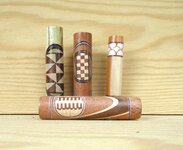You are using an out of date browser. It may not display this or other websites correctly.
You should upgrade or use an alternative browser.
You should upgrade or use an alternative browser.
One step forward two steps back
- Thread starter Alan Morrison
- Start date
Signed-In Members Don't See This Ad
Signed-In Members Don't See This Ad
Penchant 4
Member
The only way anyone else knows that these designs are not what you set out to create...is because they have been told. Keep at it because frankly, these look pretty good.I am struggling with this segmenting lark. Precision is a difficult art to master.
I now have slanting squares and misaligned triangles.View attachment 334111
leehljp
Member Liaison
The vast majority of precision makers that I am familiar with - use hand tools, and spend 12+ hours a day making them. It kinda goes against the grain (no pun intended) of "power tools" with jigs frame of mind.
Keep at it. You are getting there. You have far more patience than I do.
Keep at it. You are getting there. You have far more patience than I do.
MedWoodWorx
Member
to be honest you chose the trickiest patternsI am struggling with this segmenting lark. Precision is a difficult art to master.
I now have slanting squares and misaligned triangles.View attachment 334111
MedWoodWorx
Member
what do you mean hand tools? they use hand drills?The vast majority of precision makers that I am familiar with - use hand tools, and spend 12+ hours a day making them. It kinda goes against the grain (no pun intended) of "power tools" with jigs frame of mind.
leehljp
Member Liaison
Primarily Hand planes for shaping the individual pieces - along with their small thin kerf saws and marking gauge type of razor cuts. Still, the final shape is usually done on their jigs - surfaced with a hand plane.what do you mean hand tools? they use hand drills?
It is amazing how fine they can adjust their hand planes by just tapping lightly on the ends or sides with a small hammer. I personally watched one guy adjust a hand plane to cut thinner than .001 inch. It was so thin that I could read a newspaper through it.
Bryguy
Member
Those don't look like struggles to me. They look like success. Wish I could accomplish what you have done. Nice work.
mobyturns
Member
Keep at it. You have been making steady progress and have experienced how very frustrating it can be. Once it clicks for you the progress will come fast. Attention to detail at every step. 
mark james
IAP Collection, Curator
If advanced segmenting was easy, many more would be doing it. I agree with Ken, when you finish one you are personally proud of, it is a special level of satisfaction. I admire your designs - keep inspiring us. 

sorcerertd
Member
Perfect? No, but I am VERY impressed. That is a level of precision well above what I'm able to achieve at this point.
This was exactly my first thought, and what first jumped out at me in the overall picture.The horizontal one reminds me of stitching on a football.
jebner
Member
I agree with Todd above. I'm nowhere near your skill level but I'm inspired by your efforts. Thanks!
MedWoodWorx
Member
Oh i see. A skilled craftsman working with such handtools can do wonders. I really envy these guys.Primarily Hand planes for shaping the individual pieces - along with their small thin kerf saws and marking gauge type of razor cuts. Still, the final shape is usually done on their jigs - surfaced with a hand plane.
It is amazing how fine they can adjust their hand planes by just tapping lightly on the ends or sides with a small hammer. I personally watched one guy adjust a hand plane to cut thinner than .001 inch. It was so thin that I could read a newspaper through it.
jttheclockman
Member
Alan I agree with the others, if segmenting was easy more pen turners would be doing them as opposed to casting their own blanks. You are doing this basically with hand tools or by hand. There are no lasers cutting the designs and that is what makes your work stand out. Comes down to jigs for cutting and aligning. Working with such small pieces is a huge challenge but you have shown here you have the patience to accomplish this. So keep at it and continue on. I like the blank laying down.
Alan Morrison
Member
Hank is referring to the Japanese art of Yosegi Zaiku. There are many videos on Youtube that show the process and are well worth watching.Oh i see. A skilled craftsman working with such handtools can do wonders. I really envy these guys.
Alan
MedWoodWorx
Member
Ok,i didn't know it is called that, i ve seen many such videos. The japanese really take things to another level; even their whiskey is good.Hank is referring to the Japanese art of Yosegi Zaiku. There are many videos on Youtube that show the process and are well worth watching.
Alan

